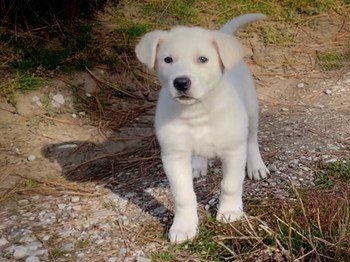How I combined opposite dog training methods to teach Yeti to "down"
By Jennifer Stoeckl, MAT - Dire Wolf Project CEO, Nov. 17, 2023
Today I want to describe how I used two opposite training methods to aid Yeti in learning the word “down”.
Of course, Yeti already knows how to lie down. She does it all the time on her own.
What she doesn’t know is the word.
So the objective is for Yeti to pair the spoken English word “down” with the physical action she already knows how to do.
There are two opposite methods to teach this to a dog: traditional and all-positive.
- The traditional way would be to say the word “down”, then manipulate the dog’s body into position. Reward. Example: https://youtu.be/ueelLm6XpJk?feature=shared
- The all-positive way would be to catch the dog as it is about to lie down. Say the word “down”. When the dog completes the down, mark the behavior (click or verbal). Reward. Example: https://youtu.be/E9IXKuewJDE?feature=shared&t=776
In the traditional version, the dog is a passive participant in the learning process. The dog waits for the person to move them. Repetition is the name of the game in this method.
In the all-positive version, the dog is an active participant in the learning process. The dog offers behaviors in order to solve the mystery of what task the human wants. Problem-solving is the name of the game in this method.
The traditional method is quick to teach, but the dog usually has low motivation due to the passive nature.
The all-positive method is highly motivational due to the active nature, but usually takes a good deal of time to capture the correct behavior.
When you combine the best of the traditional method (quick task compliance) with the best of the all-positive method (higher motivation), you get a dog that understands to problem-solve on its own, but also to ask for help when confused.
It’s a great way for a reciprocal, two-way communication.
A soft companion dog does NOT want to be confused for too long.
Confusion breeds disinterest in our dogs.
Therefore, it is best to relieve any frustrated confusion when you notice it.
Here’s what I did for Yeti.
Yeti is highly motivated by steak jerky… YUM!
I took the jerky and brought it from her nose in between her toes, closer to her body.
She would bring her head down and round her back to get at the treat, but didn’t “offer” to down.
I tried over and over different times, but she just wasn’t offering me a different behavior.
She eventually went around my hand in confusion, then looked up at me and whimpered. (That was her ask for help!)
So, I said the word “down” and placed two fingers on her withers, pressing down as I lured her head down with the food reward. (traditional approach)
She initially resisted by locking her legs.
I did not release pressure until…
seconds later, she gave to the pressure and downed.
THE VERY MOMENT she released the pressure of my two fingers on her withers by moving her body down, I marked the behavior (verbal “yes”) and gave her the treat. (all-positive)
SUCCESS!
The next time, I lured her without using finger pressure to see if she understood.
Again, she simply moved her head down and then walked in a circle around my hand.
As a reminder, I placed two fingers on her withers using less pressure than before. She remembered and downed… then… the verbal mark (“yes”) and reward followed.
The third time…
I lured… she downed… mark… reward!
By jove, I think she’s got it!
Now… she understands “down” using the word + luring.
But, she doesn’t yet know the English word “down” without the lure as a reminder.
So, now I say the word “down” and wait (no lure).
Of course, she offers me wrong behaviors (stand, sit)…
because she hasn’t associated the spoken English word for the behavior.
She still thinks in body language.
After all, it is her native language!
When she jumped up and whimpered, I knew she was confused.
CONFUSION MEANS “HELP!”
So, I used the lure as a guide, but this time only moving my hand half-way down to the ground.
She remembered the cue and “downed”.
YES! Mark/reward.
Over the course of three lessons, I used fewer and fewer body language cues.
UNTIL…
Yesterday, Yeti downed when I said “down” BEFORE I used the lure.
YAHOO!!
Yeti now understands the spoken English word “down” means to place elbows and belly on the ground!
No waiting weeks to “capture” the down enough times for her to understand the connection.
And…
She retains a high motivation for problem solving new learning because I only provided enough pressure to help her figure it out on her own when she became confused and needed help.
This is why I LOVE balanced training techniques.
It’s the best of both worlds.
We simply worked together to learn the new English word.
The Canine Culture Shock intuitive dog training series is being written. I hope to complete it by late spring 2024.
But… you can get the prequel to the Canine Culture Shock series right now.
The DireWolf Guardians PHILOSOPHY book gets you prepared for what’s to come.
Plus, this hard-bound book has many heart-warming illustrative stories and lots of professional full-color, full-page photos of our dogs.
That’s why it makes a unique gift for the holidays, too.
Here’s the link:
https://direwolfproject.com/direwolf-publishing/dire-wolf-project-books/non-fiction-books/direwolf-guardians-philosophy-book/
Learn all you can!
Your dog deserves your best.
Jennifer Stoeckl is the co-founder of the Dire Wolf Project, founder of the DireWolf Guardians American Dirus Dog Training Program, and owner/operator of DireWolf Dogs of Vallecito. She lives in the beautiful inland northwest among the Ponderosa pine forests with her pack of American Dirus dogs.